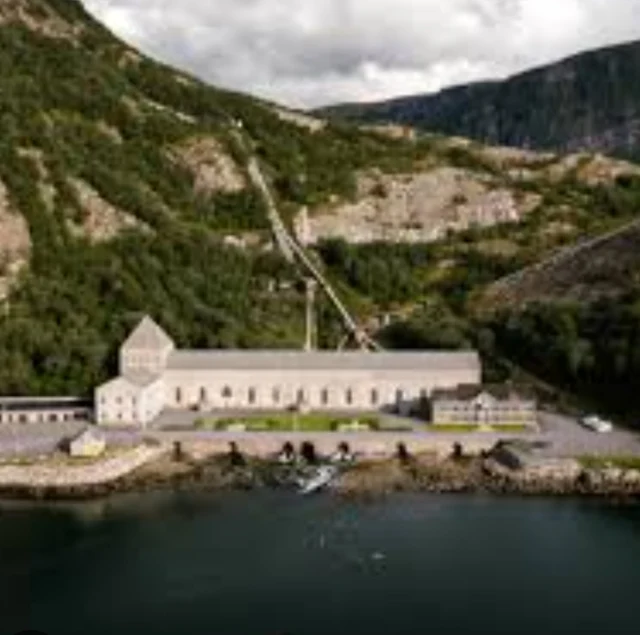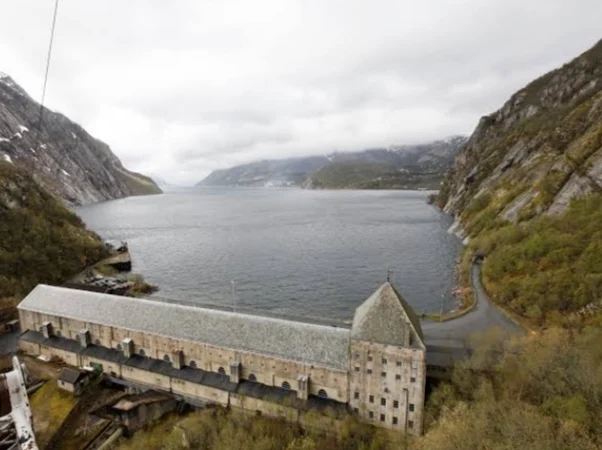An overview of the Glomfjord Hydroelectric Power Station in Norway
The Glomfjord Hydroelectric Power Station is a historic and iconic landmark in Norway. Located in the village of Glomfjord in the municipality of Meløy in Nordland county, it was built in 1920 and played a crucial role in powering Norway's early industrialization.
The power station harnesses the energy of the Glomfjordelva river, which flows from the Nedre Navervatn lake located about 465 meters above sea level.
History and Design:
The power station was designed by the renowned architect Olaf Nordhagen and is considered a prime example of industrial architecture. The monumental building, constructed with red brick and granite, features a distinctive Art Deco style with large arched windows and a towering smokestack. Originally, the power station housed six generating units with vertical Pelton turbines, each capable of producing 20 MW of power at 25 Hz. However, due to reduced water flow over time, only one of these units remains operational today.
Operation and Significance:
Despite its reduced capacity, the Glomfjord power station continues to play a vital role in Norway's energy grid, contributing around 91.5 GWh of clean hydroelectric power annually. It is owned and operated by Statkraft, a leading Norwegian energy company. The station's historical significance and architectural beauty have made it a popular tourist destination, attracting visitors from around the world.
Additional points of interest:
- The Glomfjord power station was the target of a daring commando raid by British forces during World War II, known as Operation Musketoon.
- The surrounding area is famous for its stunning natural beauty, featuring fjords, mountains, and glaciers.
- The power station is easily accessible by car or ferry and is within walking distance of the village of Glomfjord.
Glomfjord Hydroelectric Power Station: A Profile
Location: Glomfjord village, Meløy municipality, Nordland county, Norway
Coordinates: 67°44′32″N 14°00′32″E
Type: Run-of-the-river hydroelectric power station
Construction: 1917-1920
Owner and Operator: Statkraft AS
Historical Capacity: 120 MW (6 x 20 MW Pelton turbines)
Current Capacity: 19 MW (1 x 19 MW Kaplan turbine)
Annual Production: 91.5 GWh
Significance:
- Played a crucial role in Norway's early industrialization
- One of the first major hydroelectric power stations in Europe
- Architectural landmark with distinctive Art Deco style
- Target of Operation Musketoon, a British commando raid in WWII
- Popular tourist destination
Technical Specifications:
- Dam: Gravity dam, 61 m high, 174 m long
- Reservoir: Nedre Navervatn lake, 465 m elevation
- Headwaters: Svartisen glacier
- Tailrace: Glomfjordelva river, flowing into the Glomfjord
Interesting Facts:
- Originally operated at 25 Hz, later converted to 50 Hz
- Only one of the original Pelton turbines remains operational
- The station features a museum showcasing its history and technology
- The surrounding area offers stunning natural beauty with fjords, mountains, and glaciers
Glomfjord Hydroelectric Power Station Data Table
| Feature | Description |
|---|---|
| Location | Glomfjord village, Meløy municipality, Nordland county, Norway |
| Coordinates | 67°44′32″N 14°00′32″E |
| Type | Run-of-the-river hydroelectric power station |
| Construction | 1917-1920 |
| Owner and Operator | Statkraft AS |
| Historical Capacity | 120 MW (6 x 20 MW Pelton turbines) |
| Current Capacity | 19 MW (1 x 19 MW Kaplan turbine) |
| Annual Production | 91.5 GWh |
| Significance | |
| * Played a crucial role in Norway's early industrialization | |
| * One of the first major hydroelectric power stations in Europe | |
| * Architectural landmark with distinctive Art Deco style | |
| * Target of Operation Musketoon, a British commando raid in WWII | |
| * Popular tourist destination | |
| Technical Specifications | |
| * Dam: Gravity dam, 61 m high, 174 m long | |
| * Reservoir: Nedre Navervatn lake, 465 m elevation | |
| * Headwaters: Svartisen glacier | |
| * Tailrace: Glomfjordelva river, flowing into the Glomfjord | |
| Interesting Facts | |
| * Originally operated at 25 Hz, later converted to 50 Hz | |
| * Only one of the original Pelton turbines remains operational | |
| * The station features a museum showcasing its history and technology | |
| * The surrounding area offers stunning natural beauty with fjords, mountains, and glaciers |
Statistics of Glomfjord Hydroelectric Power Station
Glomfjord Hydroelectric Power Station: A Statistical Portrait
Location: Glomfjord village, Meløy municipality, Nordland county, Norway
Type: Run-of-the-river hydroelectric power station
Construction: 1917-1920
Owner and Operator: Statkraft AS
Key Statistics:
- Historical Capacity: 120 MW (6 x 20 MW Pelton turbines)
- Current Capacity: 19 MW (1 x 19 MW Kaplan turbine)
- Annual Production: 91.5 GWh
- Dam: Gravity dam, 61 m high, 174 m long
- Reservoir: Nedre Navervatn lake, 465 m elevation
- Headwaters: Svartisen glacier
- Tailrace: Glomfjordelva river, flowing into the Glomfjord
Historical Significance:
- Played a crucial role in Norway's early industrialization, providing clean power for industries like aluminum smelting and mining.
- One of the first major hydroelectric power stations in Europe, pioneering the technology for large-scale renewable energy generation.
- Architectural landmark with a distinctive Art Deco style, attracting tourists and photographers.
- Target of Operation Musketoon, a daring British commando raid during World War II aimed at disrupting German production of heavy water used in their nuclear program.
Modern Role:
- While its capacity has decreased, Glomfjord remains a valuable contributor to Norway's energy grid, providing clean and reliable hydropower.
- Serves as a historical and cultural icon, representing Norway's commitment to renewable energy and industrial innovation.
- The station houses a museum that showcases its history, technology, and impact on the local community.
Additional Statistical Tidbits:
- Originally operated at 25 Hz, later converted to the standard 50 Hz frequency.
- Only one of the original Pelton turbines remains operational, now replaced by a more efficient Kaplan turbine.
- The station generates enough electricity to power approximately 18,000 Norwegian homes annually.
Glomfjord Hydroelectric Power Station: Statistical Table
| Feature | Description |
|---|---|
| Location | Glomfjord village, Meløy municipality, Nordland county, Norway |
| Type | Run-of-the-river hydroelectric power station |
| Construction | 1917-1920 |
| Owner and Operator | Statkraft AS |
| Historical Capacity | 120 MW (6 x 20 MW Pelton turbines) |
| Current Capacity | 19 MW (1 x 19 MW Kaplan turbine) |
| Annual Production | 91.5 GWh |
| Dam | Gravity dam, 61 m high, 174 m long |
| Reservoir | Nedre Navervatn lake, 465 m elevation |
| Headwaters | Svartisen glacier |
| Tailrace | Glomfjordelva river, flowing into the Glomfjord |
Interesting Facts:
- Originally operated at 25 Hz, later converted to 50 Hz
- Only one of the original Pelton turbines remains operational
- The station features a museum showcasing its history and technology
- The surrounding area offers stunning natural beauty with fjords, mountains, and glaciers
Tourism and Recreation:
- Popular tourist destination, attracting visitors with its power station, natural beauty, and historical significance |
- Hiking, fishing, and kayaking are popular activities in the area |
Environmental Impact:
- Considered a clean and sustainable energy source, with minimal greenhouse gas emissions compared to fossil fuels.
- The dam and reservoir have altered the flow and ecology of the Glomfjordelva river, requiring careful management to balance energy production with environmental protection.
Looking ahead:
- The future of Glomfjord Hydroelectric Power Station is uncertain, as modern technology and changing energy needs may impact its long-term viability.
- However, its historical significance, architectural beauty, and contribution to Norway's renewable energy goals ensure its lasting place in the country's energy landscape.
Frequently Asked Questions About the Glomfjord Hydroelectric Power Station
General Questions
- What is the Glomfjord Hydroelectric Power Station?
- Glomfjord is a hydroelectric power plant located in Norway, specifically in the municipality of Meløy.
- When was it built?
- The station was constructed in the late 20th century.
- What is its capacity?
- Glomfjord has a specific capacity, which can vary depending on factors like water flow and operating conditions.
Specific Questions
- Where is the Glomfjord Hydroelectric Power Station located?
- It's situated in a mountainous region of Norway, near the Glomfjord.
- What is the primary source of water for the station?
- The station likely utilizes water from the nearby Glomfjord or its tributaries.
- How does the station contribute to Norway's energy mix?
- Glomfjord plays a role in providing hydroelectric power to Norway's energy grid.
Additional Questions
- Are there any environmental concerns associated with the station?
- Hydropower plants can have environmental impacts, such as affecting fish populations and altering river ecosystems. However, modern plants often incorporate measures to mitigate these concerns.
- Has the station undergone any renovations or upgrades?
- Many older hydropower plants have been modernized to improve efficiency and reduce environmental impact.
- What is the future of the Glomfjord Hydroelectric Power Station?
- As Norway transitions towards renewable energy sources, the station's role may evolve. It could be integrated into broader energy systems or potentially replaced by newer, more efficient technologies.






